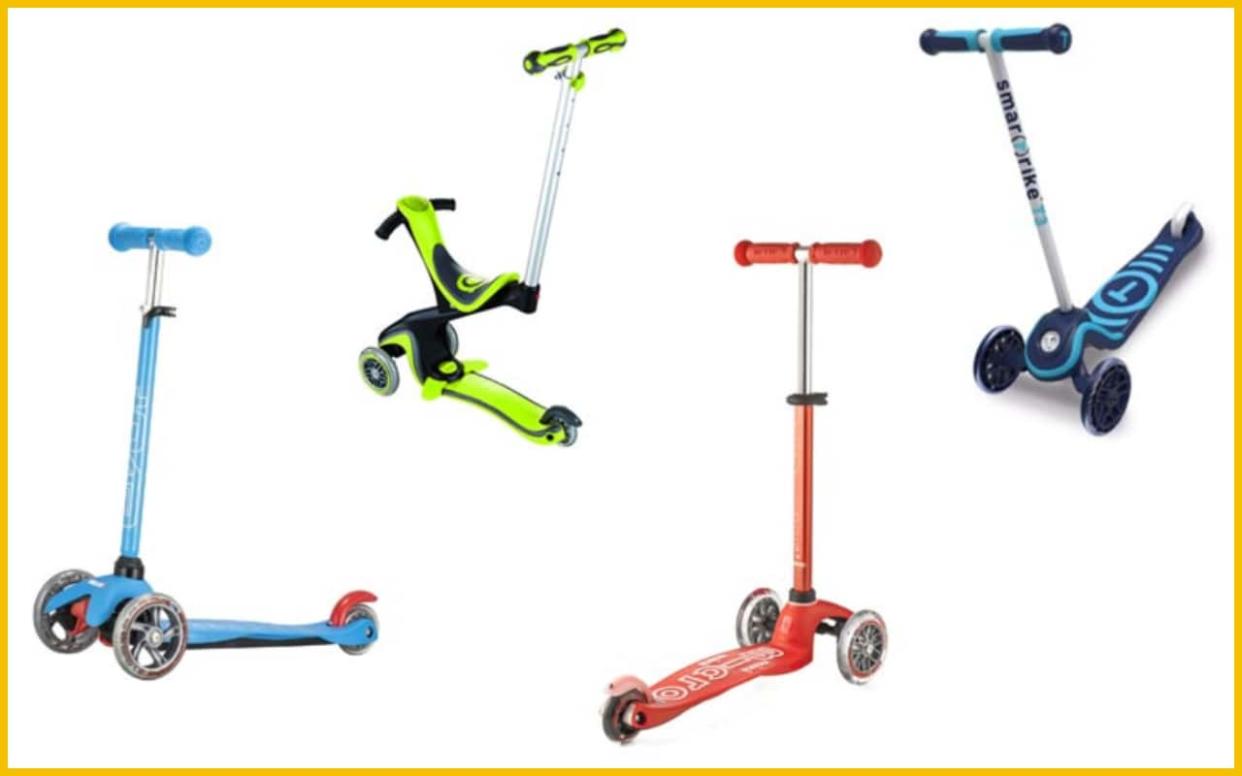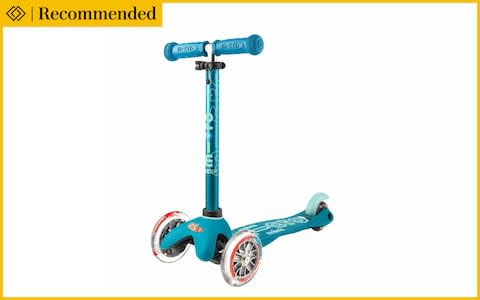The best scooters for kids

What did we do before scooters? Speedy, compact and fun, they’re now a wildly popular mode of transport for adults and kids alike – and for toddlers they are a dream toy, allowing energetic little ones to travel with the speed and independence they crave.
Parents love them too because they’ll occupy a child for hours, build psychomotor skills including coordination and balance, and slash journey times without having to resort to a pushchair. Little wonder that scooters are consistently one of the most requested and purchased toys of the year.
There are now dozens of models available at a wide range of price points, but choosing the right scooter for your toddler is crucial. Even a two-year-old can soon start to pick up serious speeds, so you should look for a scooter that’s safe, secure and durable – and that’s built to last so they can keep enjoying it as they grow. So, do ask about the materials, the steering and the brake, and do try it out in the shop to see how smooth it feels and how well it takes corners.
I’d also argue that it’s vital to check the weight of a scooter, and to ensure it’s foldable or compactable for transport and storage.
If you’re not sure if your toddler will take to scootering (and not all of them do), it can be tempting to start off with a cheaper model – some are priced as low as £20. However, having road tested a bunch with my two-year-old daughter, at a range of price brackets, I’d advise against this. The cheapest scooters for kids tended to be clunky, rickety and heavy – which you’ll seriously regret when you’re carrying it home with your toddler on the other arm.
Buying a scooter should be like buying a bike, says Nick Warry, manager and buyer at leading London skate shop Slick Willies. “You get what you pay for, and if you go very cheap it just won’t be as nice or as fun for them to ride, and will end up falling apart.”
Fancy trying scooting out yourself? See our guide to the best scooters for adults
You want to give your toddler a positive first experience of riding. So if you’re unsure about spending on a decent model, it’s probably a better idea to borrow one or look out in second hand shops or online.
All the scooters reviewed below are three wheeled designs. These are considered safest for two- to five-year-olds because they provide better balance when turning, and thus a lower risk of falling off, though Warry says he sometimes sells two wheelers to four-year-olds who are tall and already confident riders.
One brand currently dominates the UK market – but are Micro scooters really worth the hype, and do any of the leading competitors match up?
Here’s my pick of the best scooters for toddlers on the market, starting with my favourite.
1. Mini Micro Deluxe
Why we like it: Light, durable, easy to use – Micro's reputation as the best scooter in town is well earned

I was somewhat cynical about the extraordinary monopoly that Micro seems to have over kids’ scooters in Britain – they’ve become as ubiquitous a middle-class statement as a wood burning stove or a My Waitrose bag for life. But there’s a reason these vibrantly coloured, Swiss-designed scooters are such a common sight: for quality, design and longevity, they cannot be beaten.
Many other cheaper scooters on the market are clearly modelled on the Micro, but none have the full set of features that it offers, such as the lightweight frame; streamlined, anti-slip footplate; and the handlebar, which is fully adjustable to ensure it’s the perfect height, and removable, meaning it neatly packs into a car boot or rucksack.
Most of all, it simply had the smoothest ride. My novice daughter was able to glide over kerbs and little bumps in the pavement, and attempt gentle corners without flying off.
Micro’s ‘lean to steer’ design – where the user leans their body to turn, rather than turning the handlebars – seems to come quite naturally to children after a bit of practice, and it ultimately makes for an easier, more secure scoot.
Price wise, they’re definitely at the top of the range, but every parent I spoke to who owns one feels it was worth it because with a bit of care (see below), they’ll last for years. This is thanks to the high quality materials and the fact all the parts are replaceable, meaning they can often be handed down to younger siblings when the time comes.
The Deluxe is the latest redesign of Micro’s classic range for kids, and it improves upon the original by way of the adjustable handlebar, anodised stem – meaning it’s protected from chips and scratches – and silicone design on the footplate, providing good grip.
The Deluxe Mini also has a higher upper weight limit of 35kg (3st 2lbs), compared with the older model’s limit of 20kg (3st 2lbs), meaning kids can keep riding it for longer – just keep notching up the handlebar as they grow.
2. Globber EVO Comfort
Why we like it: A trike, bike and scooter all-in-one

Globber is now a respected brand on the scooter landscape, having carved out a name with its multi-tasking models such as the EVO Comfort which can be adapted to a pushalong trike, then a walking bike and finally a scooter when the time is right. Parents short on space (and who isn’t?) will appreciate the neat idea of combining all these modes of transport into one.
Scooters with a detachable ride-on seat (Micro have a similar offering) can be used from a young age – recommended from 15 months up – but are also a good idea for any toddler who is apprehensive about stand-on scooters, as they allow them to develop their balance from a position of safety. The seat is adjustable to three different heights and seemed comfortable and sturdy; my guinea pig was soon confidently gliding around on it, using her feet to pedal along the floor.
The Globber is cleverly made with good quality materials and smooth to ride. Using the pushalong setting, where the scooter handlebar doubles up as a handle for a grown-up to steer the trike from the back, I found the steering a bit unwieldy – because it’s a little on the heavy side.
As a scooter it’s of comparable quality to the Micro in terms of design and suspension. It has a maximum user weight of 50kg, with the handlebar adjusting up to a maximum height of 825mm, so it can be enjoyed for years to come. I found, though, that the handlebar only drops down to a minimum height of 675mm – so it was slightly too high for my two-year-old daughter to start scootering straight away.
It’s undoubtedly on the expensive side, but in terms of quality and multifunctionality, it's up there with the best.
3. John Lewis & Partners My First Scooter

John Lewis’s own brand offering has a solid and sturdy footplate, supporting riders up to 50kg in weight (it should last a child up to the age of six), though this does mean the scooter itself is a bit on the heavy side.
Kids will love to show off the light-up wheels when out and about, and these also offer visibility for parents legging it after them (though it’s not generally advised for children to ride scooters in the dark). The scooter has a steering lock, meaning children can master the basics of riding before trying out steering by leaning their weight.
However, the price is not far off that of a Micro scooter – and there’s a case for spending the extra £20 or £30 to get a superior model. I also would have liked to have seen some more gender-neutral colour options (it's currently available in blue or pink).
4. smarTrike T3 T-Scooter

Currently reduced from £43.99 to £38.99, Argos
For the price, this is a decent, strong and stable scooter, also with a steering lock for younger riders to learn the ropes safely. This can then be unlocked when they get more confident turning corners.
However, the smarTrike is let down by two issues. Firstly, it is not compactable. The handlebar can be taken out, but it’s rather fiddly. Secondly, and for me more significantly, the handlebar only has one fixed height. This limits the use and value of the scooter, since as soon as your child is too tall for it (see below for information on the ideal scooter height), you’ll have to buy a new one.
5. Evo Atom Mini

Currently reduced from £32 to £20, Halfords
This has a removable handlebar, meaning compact storage and the intuitive, lean-to-steer design. It weighs in at 1.8kg (the Micro Deluxe weighs 1.9kg) so won’t be too heavy for your child to lift themselves when they’re approaching steps or kerbs.
It felt slightly juddery to ride, but was the best of the budget options I tested.
The handlebar is adjustable, but only to three set heights, with a maximum height of 70cm. The scooter’s maximum user weight limit is 20kg – so it’s more limited in terms of lifespan than the more expensive models.
If you’re on a tight budget and happy to sacrifice a bit on quality and features, you could do worse.
Buy now
FAQs
What height should the handlebar be?
A scooter’s handlebars should be between your child's midriff and nipples, says Nick Warry at Slick Willies. “Too low, and it’s easy for them to fall over the front; too high and they’ll have their hands in their face.”
How should I look after my child's scooter?
The best scooters are made from durable and weather- resistant materials, but Warry says they should still always be kept inside – not in the garden or even the shed, because damp and rain will rust the bearings.
“Once you’ve bought a scooter, check everything’s tight, and then from time to time loosen them fully and tighten them up.”
You might consider labelling the scooter on the bottom with your child’s name to protect against loss.
How can I keep my child safe on their scooter?
Children should always wear a well-fitted helmet when riding a scooter. It’s best to practice in parks before they’re confident enough to start pounding the pavements, says Warry. They should be supervised by an adult at all times - in particular when on the streets so you can ensure they stop before crossing the road. Avoid scootering in wet, muddy and icy conditions, or in the dark.


 Yahoo News
Yahoo News 
